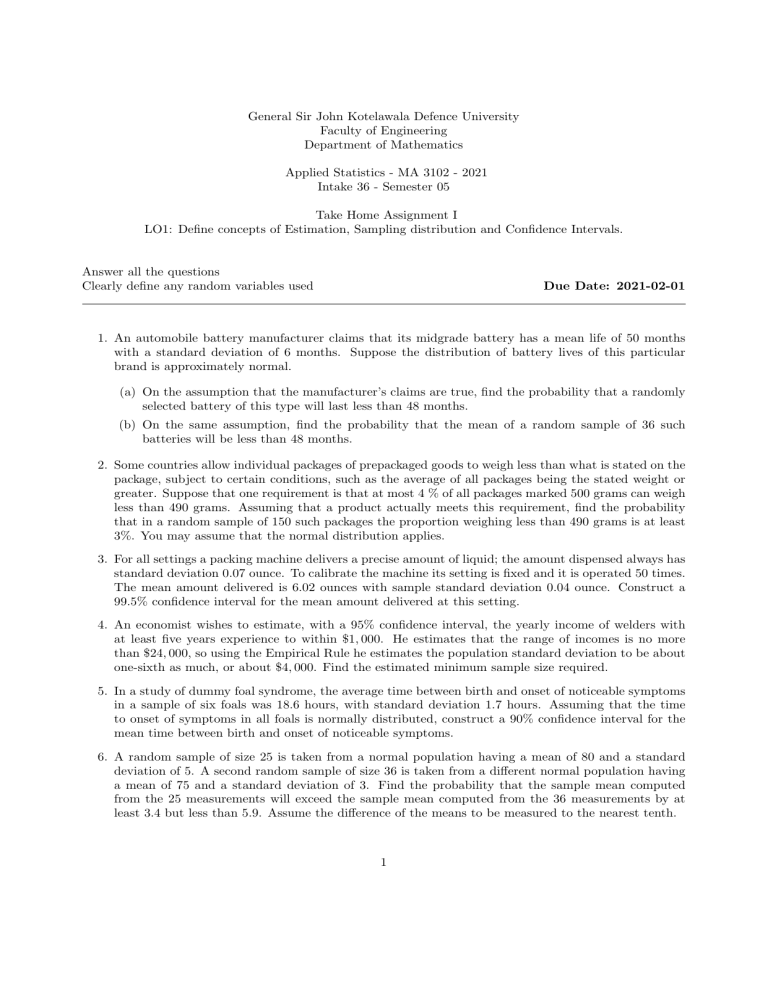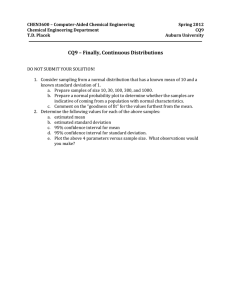
General Sir John Kotelawala Defence University Faculty of Engineering Department of Mathematics Applied Statistics - MA 3102 - 2021 Intake 36 - Semester 05 Take Home Assignment I LO1: Define concepts of Estimation, Sampling distribution and Confidence Intervals. Answer all the questions Clearly define any random variables used Due Date: 2021-02-01 1. An automobile battery manufacturer claims that its midgrade battery has a mean life of 50 months with a standard deviation of 6 months. Suppose the distribution of battery lives of this particular brand is approximately normal. (a) On the assumption that the manufacturer’s claims are true, find the probability that a randomly selected battery of this type will last less than 48 months. (b) On the same assumption, find the probability that the mean of a random sample of 36 such batteries will be less than 48 months. 2. Some countries allow individual packages of prepackaged goods to weigh less than what is stated on the package, subject to certain conditions, such as the average of all packages being the stated weight or greater. Suppose that one requirement is that at most 4 % of all packages marked 500 grams can weigh less than 490 grams. Assuming that a product actually meets this requirement, find the probability that in a random sample of 150 such packages the proportion weighing less than 490 grams is at least 3%. You may assume that the normal distribution applies. 3. For all settings a packing machine delivers a precise amount of liquid; the amount dispensed always has standard deviation 0.07 ounce. To calibrate the machine its setting is fixed and it is operated 50 times. The mean amount delivered is 6.02 ounces with sample standard deviation 0.04 ounce. Construct a 99.5% confidence interval for the mean amount delivered at this setting. 4. An economist wishes to estimate, with a 95% confidence interval, the yearly income of welders with at least five years experience to within $1, 000. He estimates that the range of incomes is no more than $24, 000, so using the Empirical Rule he estimates the population standard deviation to be about one-sixth as much, or about $4, 000. Find the estimated minimum sample size required. 5. In a study of dummy foal syndrome, the average time between birth and onset of noticeable symptoms in a sample of six foals was 18.6 hours, with standard deviation 1.7 hours. Assuming that the time to onset of symptoms in all foals is normally distributed, construct a 90% confidence interval for the mean time between birth and onset of noticeable symptoms. 6. A random sample of size 25 is taken from a normal population having a mean of 80 and a standard deviation of 5. A second random sample of size 36 is taken from a different normal population having a mean of 75 and a standard deviation of 3. Find the probability that the sample mean computed from the 25 measurements will exceed the sample mean computed from the 36 measurements by at least 3.4 but less than 5.9. Assume the difference of the means to be measured to the nearest tenth. 1


